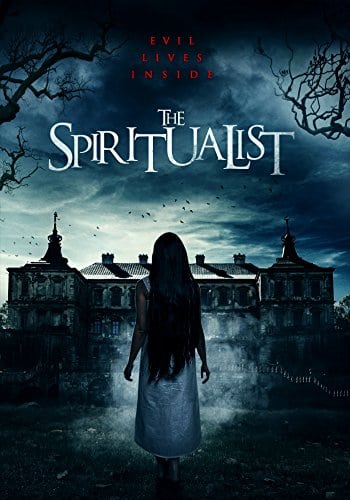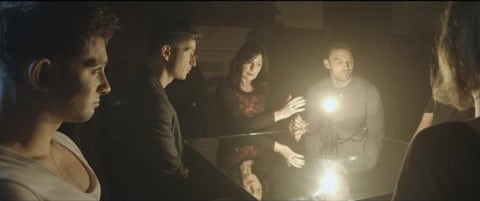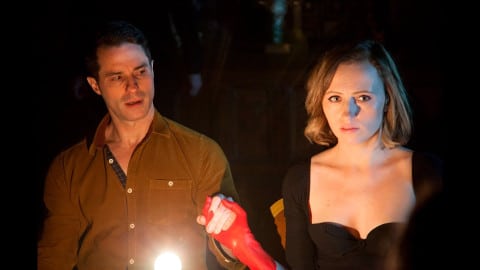The Spiritualist (2016)
Directed by: Carl Medland
Written by: Carl Medland
Starring: Caroline Burns Cooke, Jasmyn Banks, Judson Vaughan, Julie T. Wallace
UK
AVAILABLE ON DVD [exclusively from Amazon MOD] and all major VOD Now
RUNNING TIME: 101 mins
REVIEWED BY: Dr Lenera, Official HCF Critic
Laura lives with her boyfriend Jake in a huge mansion in the countryside. Her parents used to also live there, but her father ran away because he was unable to cope with her mother’s insanity, and her mother died of the condition soon after. Now, Laura periodically sees a ghostly figure at night time and becomes convinced that it’s her mother – unless she’s beginning to go crazy two. Her friend Petra contacts a spiritualist she knows, and she, along with friends of Laura and Jake, come to the mansion in order to perform a seance and banish any evil spirits that may lurk there….
The Spiritualist is a slightly odd sort of ghost story that’s initially in the vein of traditional spook movies like The Others or The Innocents, then dawdles for a bit before turning into a body count film [I’m not sure the term slasher is quite appropriate, as most of the killings occur offscreen]. Writer/director Carl Medlund, who made another ghost movie soon after this entitled Paranormal Farm which I definitely intend to see, certainly knows how to create that creepy-but-also-a-bit-melancholic atmosphere which is essential to any effort like this, and most definitely knows how to make the most of a very meagre budget – this film looks quite marvellous at times. However, on the evidence of this particular film [he’s made two non-horror features before this one], he’s less good at the script writing part. He has some good ideas, and the basic story is a decent one, but his screenplay here, replete with dialogue that veers from seeming very natural to very forced and fake, could have done with a polish, maybe from someone else, before it was filmed. And the first third of the film is so strong that the rest struggles to match it, though it does get there at times, including one of the most tense seance scenes I’ve watched in some time, and is only truly undone by a ridiculously rushed final act. And, while thankfully not overly reliant on “BOO” moments, there are a few genuine scares dotted about.
“Inspired by true events” it says on the titles, and I have no idea what reported supernatural case this movie was based on, though any basis in fact is probably gone after about 45 minutes. Anyway, the opening scene is quite wonderfully eerie and moody as the camera prowls through the main room of a country house, taking in various statues before entering a bedroom where a young woman is lying awake in terror, we see a silhouette beside her and – oh, it was all a dream. But poor Laura, whose boyfriend Jake had just moved in, begins to think that she’s losing it when, for example, she tells Jake that she’s unpacked his ties but he says that she didn’t tell him that at all – though I’m surprised that she would still want to live in this spooky old mansion anyway considered the trauma of much of her early life there. Her mother suffered from something called Morven’s Syndrome which only 15 other people have been diagnosed with, and which causes insomnia, hallucinations, angry outbursts and suicidal tendencies. I don’t quite know why they had to invent a name for her condition[s] which aren’t that uncommon, but never mind. She thinks that her daughter wants to sleep with her father, though he’s busy making the beast with two backs with the maid, which leads me to another thing. This couple may be well off enough to have a maid, but a grand country mansion like this? And would Laura and Jake really be able to maintain the place, especially when Laura doesn’t seem to have a job. Just a bit of backstory would have been good here.
The first third of the film has scenes set in the present intercut seamlessly with scenes in the past, sometimes quite cleverly like when Laura and Jake are talking in the garden and the camera pans right to reveal her dad pushing her mum on a swing. It’s a good way of showing how the past is constantly a major part of Laura’s present day existance, though some viewers may find it a bit confusing. Most films that deal with flashbacks tend to differentiate them from present day scenes by having them look different, but this one doesn’t do so. The past scenes benefit immensely from the considerable presence of Julie T. Wallace in fine She Devil-style form. Back in the present, Laura watches a video on bereavement which actually is a short film called Bereavement made from the same director. This is where Jane Merrow appears, so having her top billed is a bit of a lie, but never mind. One of my favourite scares in the film comes after this, a ghostly face revealed when the laptop is turned off. Like some of the other best moments in the film, it’s quick and quite subtle. If you’re not paying attention than you may miss it.
Now we get to Laura’s friends and the spiritualist [who doesn’t seem to have a name] arriving who immediately proves her skill by revealing something about Laura that seems like it’s going to be a major plot point but isn’t, really. The quality of acting, which up to now has been pretty good, goes downhill considerably with a very lengthy sequence, filmed from a distance in one long take, of the various guests getting to know each other. I’m all for economy of style because it’s seen less often these days, but some intercutting may have helped some of the performances immensely. And the dialogue is weird, convincing chatter intercut with terribly forced bits such as when they talk about their worst fears. Could this be important later on? What do you think? Actually the answer is yes and no. Eventually people start to be killed off by something or somebody [there’s ridiculously obvious red herring] utilising their greatest fears but, apart from one deliciously shivery moment of the figure of a clown rising up in the dark which for me was more frightening than almost anything in the It remake, the potential of this previously used but still good idea isn’t really capitalised on, a great shame as, while this remains a deliberately old fashioned piece, we hardly see the kills either. The biggest problem here though is probably that the nature of the screenplay has meant that all this stuff is crammed into the final 25 minutes, and would have benefitted from expansion and getting rid of some of the weaker earlier material.
The highlight is probably the seance, which goes on for quite a while, the camera circling the participants or sometimes following tiny balls of light [the only major special effect in what to me looked like a refreshingly CGI-free effort], but which certainly worked this viewer up in the right way. There is indeed a twist, and it’ll probably surprise viewers who haven’t seen the previous film this twist was used in, though it was more effective and believable there. And then things end a little confusingly, as if Medlund couldn’t decide how to finish his film. Directorially though I have few complaints. There’s a smooth elegance to his style, the camera generally preferring to keep back and observe, though one bit when a character is entering a room where we know something’s probably going to happen and the camera remains close up on his face, creating maximum claustrophobia. This is one of several moments where Medlund bravely refuses to show what people see. Meanwhile cinematographer Amarjeet Singh makes the most of the interiors of the great house, and gives us a few lovely individual shots like Laura standing beside a fog strewn lake.
The heart of the story is Laura trying to deal with the sad memories of a mother she wasn’t even sure she loved after a while, and her guilt over the latter. Is it really that bad to stop loving a loved one when they’re no longer that loved one? Jasmyn Banks does a pretty good job in her more emotional scenes though isn’t always that convincing in her quieter moments. It’s always nice to see Petra Bryant in a film though she’s oddly wooden here. And Caroline Burns Cooke as the Spiritualist is just bizarre, all over the place and even seeming to miss her timing on a couple of occasions. I should also mention Mumtaz Yildirimlar ‘s very ambient score which often aids the atmosphere of some scenes, though is maybe laid over too many of them, some of which could have benefitted from having very little sound at all. Most of these are of characters wandering around the house, in fact there’s a hell of a lot of footage of characters wandering the house in this film. This is the kind of thing which can seem like padding and which can bore easily in the wrong hands, but I was ‘into’ the film enough to not be distracted, which certainly means that The Spiritualist was certainly working for me a fair bit. It’s in many of the non-horror bits where this film falls down. It’s often rather clumsy in its writing and doesn’t do all it could with its premise[s] – yet all in all it’s a reasonable effort that certainly has more style than your average cheapie straight to DVD horror flick.








Be the first to comment